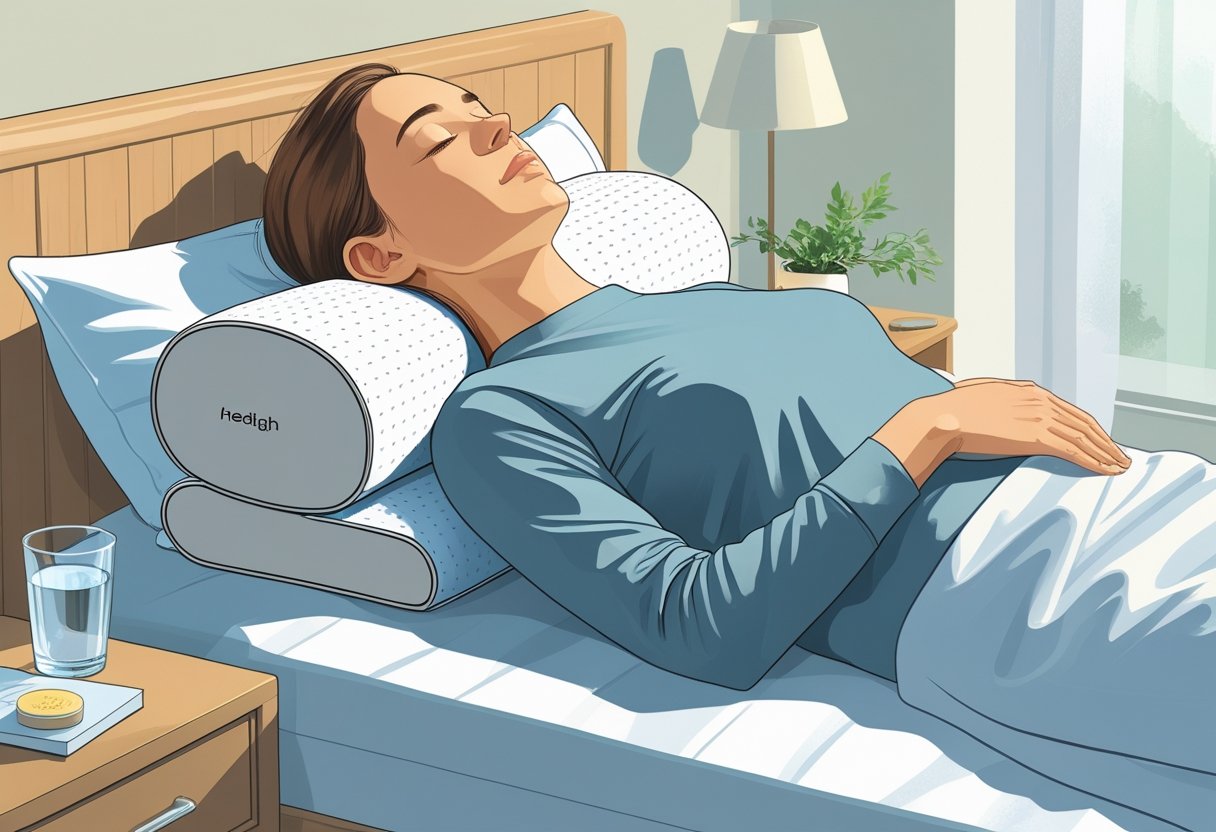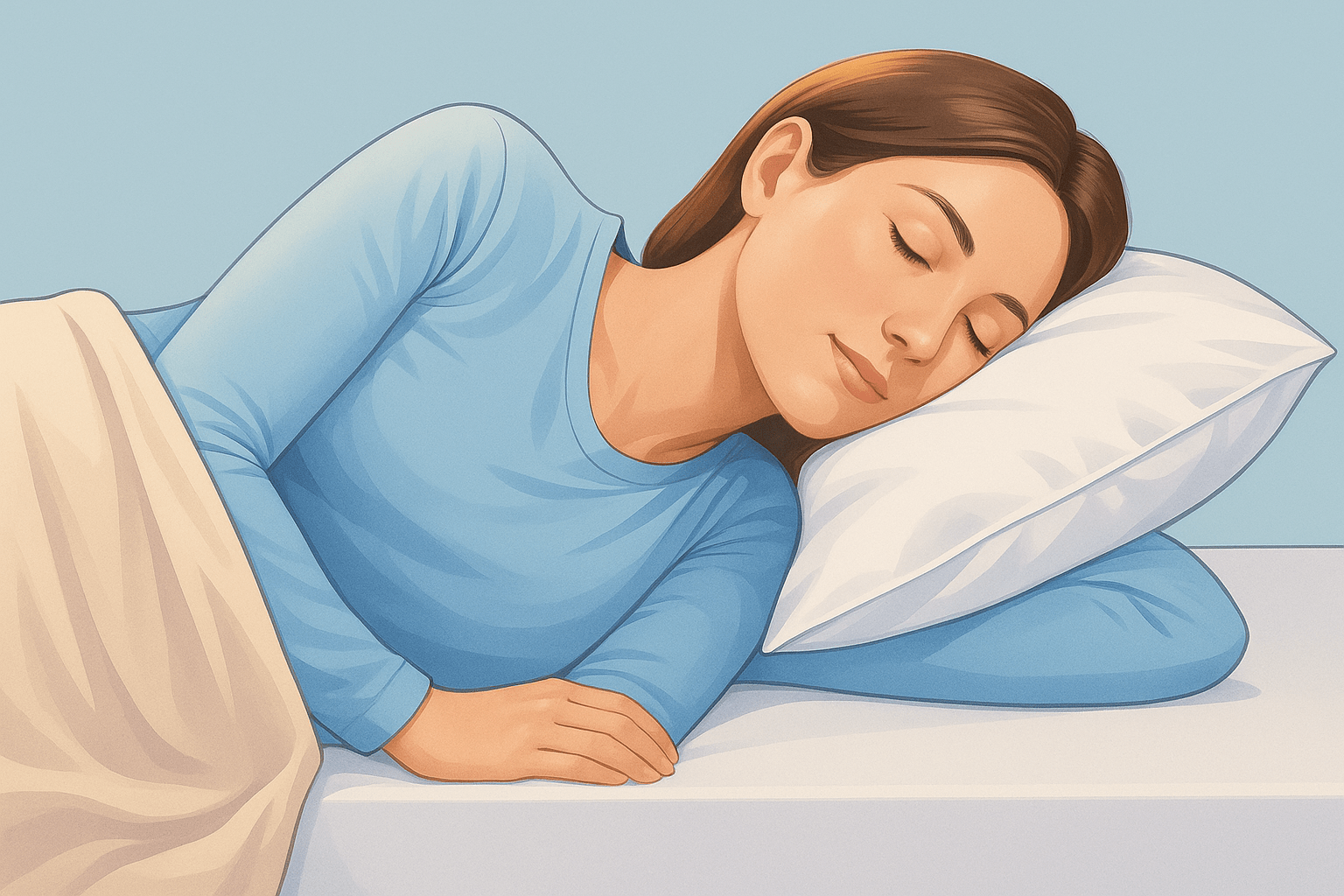Neck pain can make it really hard to fall asleep and stay comfortable through the night. One of the best ways to sleep when your neck is hurting is to lie on your back or side with a supportive pillow that keeps your neck in line with your spine. Try to avoid sleeping on your stomach, since that position can put extra strain on your neck and make the pain worse.
Having the right pillow can make a big difference. It fills the space between your neck and the mattress, giving your neck the support it needs and easing muscle tension. Just adjusting how you sleep and the pillow you use can help reduce discomfort and lead to better sleep for anyone struggling with neck pain.
Even small tweaks to your sleep habits and environment can go a long way in managing neck pain. Learning a few simple ways to support your neck while you rest can really help relieve the pain and stop it from getting worse.
Key Takeaways
- Sleeping on the back or side supports neck alignment best.
- A proper pillow reduces neck strain during sleep.
- Adjusting sleep habits can improve neck pain and rest quality.
- Choosing a mattress with the right firmness helps maintain spinal alignment and can ease neck pain.

Neck pain during sleep often comes from physical strain or poor sleeping posture. It can really affect how well a person sleeps and can even linger into the next day if it’s not taken care of. Understanding what causes neck pain and the role sleep plays in it is key to finding some relief.
Common Causes of Neck Pain During Sleep
Neck pain often comes from sleeping in a way that puts too much pressure on the muscles or joints. If your pillow is too high or too flat, it can throw your neck out of alignment. Sudden movements during the night or sleeping on an old, unsupportive mattress can also lead to discomfort.
Injuries like neck strain or stiffness might be caused by overuse during the day or from sleeping in a weird position. People who deal with neck and shoulder pain often wake up sore because of muscle tension that builds up while they sleep.
The Relationship Between Sleep and Neck Pain
The position you sleep in plays a big role in neck health. Sleeping on your side or back generally puts less strain on the neck compared to sleeping on your stomach, which can twist your neck in an awkward way. The right pillow helps keep the natural curve of the neck supported.
Keeping your neck in line while you sleep is a big help in easing pain. For instance, using a rolled-up towel under the neck or a pillow that’s shaped to support your neck can help your spine stay in a neutral position. These tips are especially useful if you’re dealing with a stiff neck or neck strain.
How Poor Sleep Aggravates Neck Discomfort
Not getting good sleep can make neck pain worse by increasing muscle tightness and inflammation. Tossing and turning from discomfort just makes the muscles even tenser. Plus, poor sleep lowers your body’s ability to heal itself during the night.
Bad posture during sleep, combined with restlessness, can create a cycle where the pain keeps getting worse. This often leads to more issues like headaches, sore shoulders, and stiffness. Figuring out how to sleep better with neck and shoulder pain means giving your neck the right support and avoiding positions that add extra strain.
Finding a comfortable sleeping position can make a big difference in reducing neck pain and stiffness. Certain ways of lying down help keep the neck properly aligned and ease the pressure on muscles and joints. Having the right pillow is just as important as it helps maintain the neck’s natural curve and provides needed support.
Best Sleeping Position for Neck Pain
Sleeping on your back is usually the most helpful position for neck pain. It keeps your head, neck, and spine in a straight line when you use a pillow that fits well between your neck and the mattress. A thin, contoured pillow made for cervical support can really help keep your neck in the right position.
It’s a good idea to avoid sleeping on your stomach. This position makes your neck twist to the side, which puts it under a lot of strain. Back sleeping takes the pressure off the neck and can relieve stiffness. Keeping your head in a neutral position—not tilted too far forward or backward—also helps avoid extra strain.
Best Sleeping Position for Neck and Shoulder Pain
Sleeping on your side can also work well, especially if you’re dealing with shoulder pain along with neck pain. Lying on your side with a supportive, firm pillow that keeps your neck in line with your spine can prevent uneven pressure on your shoulders.
Using a pillow under your neck and another one between your knees can help keep everything—from your head to your hips—properly aligned. If you’re a side sleeper, it’s important to avoid letting your head tilt too far down or up, since either position can make neck and shoulder pain worse.
Side Sleeping vs. Back Sleeping for Neck Support
Both side and back sleeping can give your neck good support, as long as you use the right kind of pillow. Side sleepers need a thicker pillow to keep the neck level with the spine. Back sleepers, on the other hand, benefit from a thinner pillow that gently supports the neck’s natural curve.
Stomach sleeping isn’t recommended because it twists the neck and often leads to soreness or stiffness. Stretching your neck during the day can help ease pain for people who switch between sleeping positions. Picking the right pillow and choosing a mattress with the right firmness also plays a big role in how well your sleeping position supports neck health.
Proper neck support during sleep begins with making adjustments to both your pillow and mattress. The right pillow height and positioning help keep your neck aligned and can ease discomfort. At the same time, your mattress should support your body evenly so it doesn’t add extra pressure to your neck.
Choosing the Right Pillow for Neck Pain
A pillow that’s too high or too flat can force your neck into awkward angles, leading to tension or pain. Adjustable pillows are great because they let you find the height that keeps your neck in a neutral, comfortable position. Memory foam or cervical pillows that gently support the natural curve of your neck often work well to reduce strain. Pillows with a slight tilt or a concave design usually do a better job than flat ones.
Look for breathable materials that help keep your head cool through the night to avoid added discomfort. A good pillow should be firm enough to support your head but still soft enough to feel comfortable. Adjustable pillows are especially useful because they offer customized neck support and can help ease morning stiffness.
Finding the Ideal Pillow Position
Your pillow needs to keep your neck in line with the rest of your spine. If you sleep on your back, make sure the pillow supports your neck, not just your head, to help maintain its natural curve. If you’re a side sleeper, use a pillow that fills the gap between your neck and shoulder so your head doesn’t tilt awkwardly.
Try to avoid sleeping on your stomach, as that position twists your neck in an unnatural way. Keeping your head aligned with your spine goes a long way in reducing tension and soreness. You can also adjust the height of your pillow so your neck stays level, neither tilted up nor down, throughout the night. Finding the right pillow position is a simple but important step in managing pain and reducing stress on your neck muscles.
Selecting a Supportive Mattress
A mattress that supports your entire body can help relieve pressure from the neck area. If the mattress is too soft, your body might sink in and throw your spine and neck out of alignment. On the other hand, a mattress that’s too firm can create pressure points and discomfort.
Medium-firm mattresses are often the best choice for neck pain, as they offer a balance between support and softness. If possible, consider an adjustable bed or try using a wedge pillow to slightly raise your upper body. This can help keep the cervical spine in a better position, easing neck pain and improving overall comfort while you sleep. Elevating the upper body is especially helpful for people with specific neck issues.
Sleeping with neck pain means paying close attention to how you sleep and the kind of support you use. The right pillow and a well-aligned body position can take pressure off the neck. It’s also important to avoid sleep positions that strain the spine, as doing so can help reduce pain and make rest more comfortable.
How to Sleep with Neck Pain on the Left Side
Sleeping on your left side can help keep your spine aligned and take some strain off your neck. A firm pillow that fills the space between your neck and the mattress is key—it should keep your head level with the rest of your body.
You might also benefit from placing a small pillow or rolled-up towel under your neck for extra support. Make sure your shoulders rest evenly on the mattress to avoid twisting your neck. Slightly bending your knees and placing a pillow between them can help keep your hips aligned, which also reduces neck tension.
Try not to sleep with your arm under your head or pillow, as this can put extra pressure on your neck and lead to stiffness. The goal is to keep your neck in a neutral, natural position throughout the night.
How to Sleep with a Stiff Neck on the Right Side
If you’re dealing with a stiff neck on the right side, side sleeping with the right kind of support is crucial. Use a pillow that supports the curve of your neck without forcing your head too far forward or letting it drop back. Placing a pillow under your ribs can help keep your spine aligned and reduce strain on the neck muscles. Make sure your head stays in line with your spine, not tilted down or up.
Applying a warm compress or heating pad for 10–15 minutes before going to bed can loosen up tight muscles, making it easier to rest. Avoid any sharp or sudden head movements while sleeping, as these can make the stiffness worse.
How to Sleep with a Crick in Your Neck
A crick in the neck often comes from sleeping in a bad position. In this case, sleeping on your back is usually the best option as it keeps your neck straight and supports the natural curve of your spine.
Use a low, supportive pillow that fills the curve of your neck without pushing your head too far forward. If extra support is needed, a rolled towel under the neck can help. Try not to sleep on your stomach, since this position forces your head to turn and adds unnecessary strain. When changing positions during the night, move slowly to avoid making the pain worse.
Proper positioning and taking care of your muscles can go a long way in easing neck pain and stiffness. Supportive pillows and gentle bedtime routines help keep neck muscles relaxed throughout the night. It’s also important to avoid putting pressure on any sore or injured areas.
How to Sleep with a Pulled Neck Muscle
Sleeping on your back or side is generally better when dealing with a pulled neck muscle. Avoid sleeping on your stomach because this position makes you twist your neck and can make the pain worse. A soft, supportive pillow is key to keeping your neck aligned with your spine.
A rolled towel or cervical pillow can help fill the space between your head and shoulder when you lie on your side. This helps prevent your neck from bending in an unnatural way. You can also adjust the height of your pillow to keep your head level and reduce the chance of waking up stiff.
Try to keep your neck in a neutral, relaxed position during sleep, and avoid any sudden movements when waking up. Doing some gentle stretching in the morning can help loosen muscles that may have tightened overnight.
How to Sleep with Neck Muscle Spasm
Neck spasms can feel like sharp, painful muscle contractions that often get worse if you sleep in the wrong position. Sleeping on your back with a thin pillow helps support the neck without putting it in an awkward angle. Keeping your spine neutral throughout the night can ease tension in the muscles.
Applying an ice pack before bed can help calm inflammation and relieve spasms. Wrap it in a cloth and use it for about 15 to 20 minutes. Heating pads can be helpful later—like the next day—to relax the muscles, but they’re usually not the best choice right before bed.
If you need more support, you can use two pillows, but make sure they don’t push your neck forward. Changing your sleep position gently from time to time during the night can also help prevent stiffness.
How to Relax Neck Muscles While Sleeping
Relaxing your neck muscles while you sleep starts with using the right kind of pillow. Memory foam or water pillows are great choices because they mold to your neck’s shape and relieve pressure. Stay away from thick or overly firm pillows that can force your neck into an unnatural angle.
Try to relax your neck and shoulders before bed with some light stretching or a bit of self-massage. Gently massaging the neck in small circular motions can help ease tension. It also helps to avoid screens and stressful activities before going to sleep, as they can increase muscle tightness.
Keeping your bedroom at a comfortable temperature and using breathable bedding can prevent stiffness caused by getting too cold. Staying hydrated throughout the day also supports healthy muscle function while you sleep.
Good sleeping posture and healthy daily habits play an important role in preventing neck pain. Keeping the neck aligned and easing strain throughout the day can help you avoid discomfort. Even small adjustments can make a big difference in how your neck feels when you wake up.
Tips for Maintaining Neutral Neck Alignment
One of the best ways to prevent neck pain while sleeping is to keep your neck in a neutral position. This means your head should stay in line with your spine, so there’s no added stress on your muscles or joints.
Sleeping on your back or side usually works best. If you sleep on your back, using a supportive pillow that fills the gap between your neck and the mattress helps keep things aligned. A thinner pillow is typically better in this position so your head isn’t pushed forward.
If you sleep on your side, go for a firm pillow that keeps your head level with your shoulders. Putting a pillow between your knees can also help align your spine and reduce strain on your neck. Try not to sleep on your stomach because it twists your neck in an unnatural way. Slightly elevating your upper body with an incline pillow can also help reduce stiffness by taking pressure off your spine.
Daily Habits for Reducing Neck Strain
How you go about your day matters too when it comes to neck pain. Maintaining good posture helps reduce muscle fatigue in your neck. When you’re sitting, make sure your head stays balanced right over your shoulders, not jutting forward. Taking regular breaks to stretch your neck and shoulders can release built-up tension. Gentle stretching also improves flexibility and blood flow, both of which can ease discomfort.
Having an ergonomic workspace is key. Keep your computer screen at eye level so you’re not always looking down and putting strain on your neck. Avoid holding your phone between your neck and shoulder. It’s better to use headphones or speaker mode to avoid unnecessary tension.
Finally, staying physically active with regular exercise strengthens the muscles around your neck and shoulders. This extra support helps prevent pain from weak muscles or poor posture, whether you’re asleep or going about your daily routine.
Neck pain at night can sometimes be a sign of something more serious. Knowing when to seek help can make a big difference in preventing the pain from getting worse or leading to complications. Ongoing pain or new symptoms should never be ignored.
Symptoms That Require Professional Attention
It’s time to see a doctor if the neck pain is intense and doesn’t get better with rest or over-the-counter medication. Pain that makes it hard to stay still or move your neck freely is a red flag.
Pay attention to these warning signs:
- Numbness or weakness in your shoulders, arms, or hands
- Difficulty walking or problems with balance
- Fever that comes with a stiff neck
- A sudden, severe headache along with neck pain
- Pain that follows an injury or a fall
If you notice any of these symptoms, it’s important to get medical care as soon as possible.
Working with Healthcare Providers for Chronic Issues
If your neck pain lasts more than a few weeks or keeps coming back, it’s a good idea to talk to a healthcare provider. They might recommend exercises, physical therapy, or tests like X-rays or MRIs to figure out what’s going on.
A specialist can also help determine whether sleeping on the painful side is making things worse. Often, sleeping on the opposite side or on your back with the right pillow support can feel more comfortable. Doctors can guide you on how to adjust your sleep position, suggest ways to relieve pain, and check for other possible causes like arthritis or nerve-related issues.
When it comes to finding the best way to sleep with neck pain, the type of mattress you use matters just as much as your pillow and sleep position. A good mattress supports the entire body evenly, helping maintain proper spinal alignment throughout the night. This reduces pressure not only on the lower back and hips, but also on the neck.
For those dealing with neck pain, a mattress that is too soft may allow the body to sink too deeply, misaligning the neck and spine. On the other hand, an overly firm mattress can cause pressure points and discomfort. A medium-firm mattress is often ideal, as it offers the right balance of support and cushioning.
The Saatva Solaire Mattress is a strong option for individuals with neck pain because it features adjustable firmness settings, allowing you to personalize the support based on your comfort needs. Its multi-layer design adapts to the shape of your body while keeping the spine aligned, which can significantly reduce neck strain and stiffness. Plus, its high-quality construction and pressure-relieving comfort make it a long-term investment in better sleep and reduced pain.
Pairing the right mattress with a supportive pillow and good sleep posture creates an environment that promotes true rest and healing for the neck.











